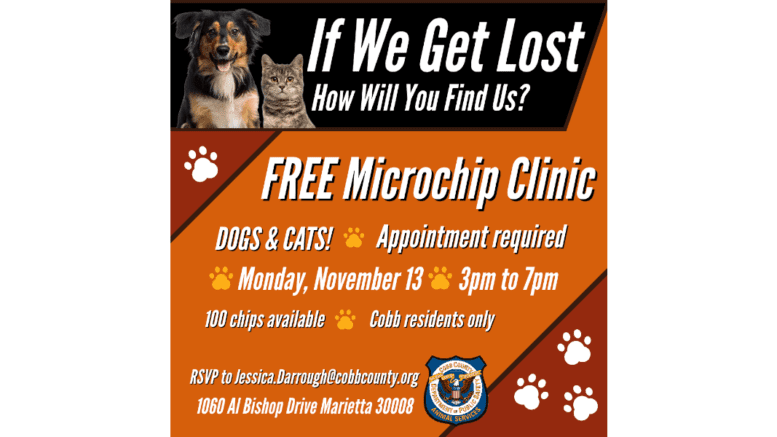by Inger Eberhart, Cobb County Department of Public Safety, Communications Specialist
Disasters can strike at any time, and they can leave you and your pet separated. Microchipping is a simple and effective way to increase your chances of being reunited with your lost pet in the event of a disaster.
What is a microchip?
A microchip is a tiny electronic device that is implanted under your pet’s skin. It contains a unique identification number that can be read by a scanner. Microchips are safe and permanent, and they do not require any batteries or maintenance.
Why is microchipping important for disaster preparedness?
There are a few reasons why microchipping is so important for disaster preparedness. First, microchips can help to identify your pet if they are found lost or injured after a disaster. Second, if your pet is evacuated to a shelter, microchipping can help to ensure that they are returned to you once the disaster has passed. Third, microchipping can help to prevent your pet from being euthanized if they are not claimed from a shelter within a certain period of time.
How does microchipping work?
Microchipping is a quick and painless procedure that can be performed by your veterinarian. The microchip is implanted under your pet’s skin between the shoulder blades. Once the microchip is implanted, it will stay in place for the rest of your pet’s life.
If your pet is found lost or injured after a disaster, they can be taken to a veterinarian or animal shelter. The veterinarian or shelter will scan your pet for a microchip. If your pet is microchipped, the scanner will read the unique identification number and display your contact information. The veterinarian or shelter will then contact you to reunite you with your pet.
RSVP to Jessica.Darrough@cobbcounty.org to get your pet microchipped for FREE at Cobb County Animal Services’ Microchip Clinic.
How to prepare for a disaster with a microchipped pet
If you have a microchipped pet, there are a few things you can do to prepare for a disaster:
- Make sure your pet’s microchip registration information is up-to-date. You can update your contact information online or by calling the microchip manufacturer.
- Bring a copy of your pet’s microchip registration information with you in your emergency kit. This will ensure that you have your pet’s microchip number in case you need to report them lost.
- Consider attaching a tag to your pet’s collar that includes your contact information and the microchip number. This will help to identify your pet if they are found lost or injured after a disaster.
Conclusion
Microchipping is a simple and effective way to protect your pet in the event of a disaster. By microchipping your pet and keeping their microchip registration information up-to-date, you can increase your chances of being reunited with your lost pet if they are separated from you during a disaster.
Additional tips
- If you are evacuating your home due to a disaster, be sure to take your pet with you. Do not leave your pet behind, as they may not be able to survive on their own.
- If you are unable to evacuate your home with your pet, contact your local animal shelter or emergency management office for assistance. They may be able to provide temporary shelter for your pet until you are able to be reunited.
- After a disaster, it is important to check with local animal shelters to see if your pet has been brought there. You can also post flyers with your pet’s picture and contact information in your neighborhood.
By following these tips, you can help to ensure that your pet is safe and protected during a disaster.
